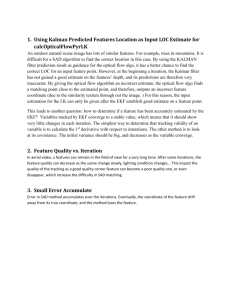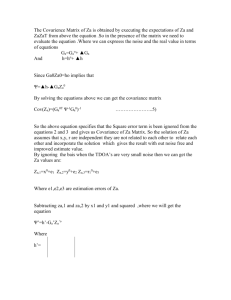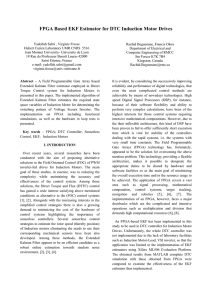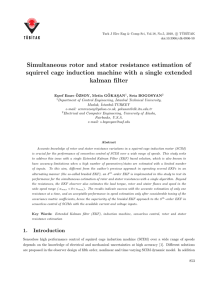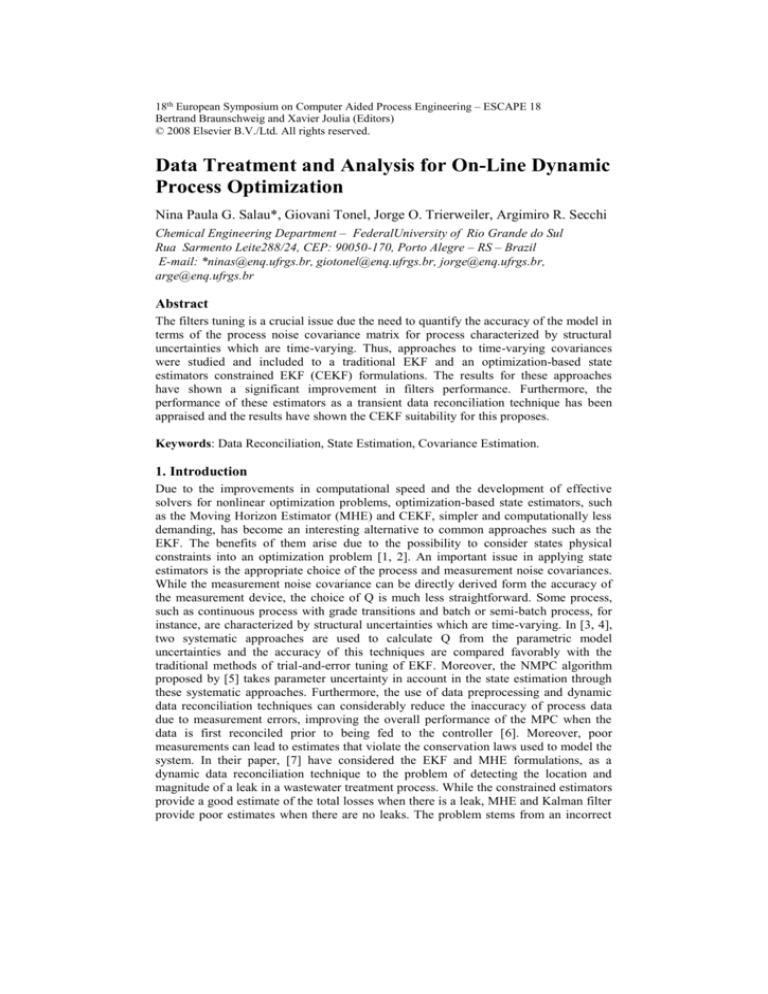
18th European Symposium on Computer Aided Process Engineering – ESCAPE 18
Bertrand Braunschweig and Xavier Joulia (Editors)
© 2008 Elsevier B.V./Ltd. All rights reserved.
Data Treatment and Analysis for On-Line Dynamic
Process Optimization
Nina Paula G. Salau*, Giovani Tonel, Jorge O. Trierweiler, Argimiro R. Secchi
Chemical Engineering Department – FederalUniversity of Rio Grande do Sul
Rua Sarmento Leite288/24, CEP: 90050-170, Porto Alegre – RS – Brazil
E-mail: *ninas@enq.ufrgs.br, giotonel@enq.ufrgs.br, jorge@enq.ufrgs.br,
arge@enq.ufrgs.br
Abstract
The filters tuning is a crucial issue due the need to quantify the accuracy of the model in
terms of the process noise covariance matrix for process characterized by structural
uncertainties which are time-varying. Thus, approaches to time-varying covariances
were studied and included to a traditional EKF and an optimization-based state
estimators constrained EKF (CEKF) formulations. The results for these approaches
have shown a significant improvement in filters performance. Furthermore, the
performance of these estimators as a transient data reconciliation technique has been
appraised and the results have shown the CEKF suitability for this proposes.
Keywords: Data Reconciliation, State Estimation, Covariance Estimation.
1. Introduction
Due to the improvements in computational speed and the development of effective
solvers for nonlinear optimization problems, optimization-based state estimators, such
as the Moving Horizon Estimator (MHE) and CEKF, simpler and computationally less
demanding, has become an interesting alternative to common approaches such as the
EKF. The benefits of them arise due to the possibility to consider states physical
constraints into an optimization problem [1, 2]. An important issue in applying state
estimators is the appropriate choice of the process and measurement noise covariances.
While the measurement noise covariance can be directly derived form the accuracy of
the measurement device, the choice of Q is much less straightforward. Some process,
such as continuous process with grade transitions and batch or semi-batch process, for
instance, are characterized by structural uncertainties which are time-varying. In [3, 4],
two systematic approaches are used to calculate Q from the parametric model
uncertainties and the accuracy of this techniques are compared favorably with the
traditional methods of trial-and-error tuning of EKF. Moreover, the NMPC algorithm
proposed by [5] takes parameter uncertainty in account in the state estimation through
these systematic approaches. Furthermore, the use of data preprocessing and dynamic
data reconciliation techniques can considerably reduce the inaccuracy of process data
due to measurement errors, improving the overall performance of the MPC when the
data is first reconciled prior to being fed to the controller [6]. Moreover, poor
measurements can lead to estimates that violate the conservation laws used to model the
system. In their paper, [7] have considered the EKF and MHE formulations, as a
dynamic data reconciliation technique to the problem of detecting the location and
magnitude of a leak in a wastewater treatment process. While the constrained estimators
provide a good estimate of the total losses when there is a leak, MHE and Kalman filter
provide poor estimates when there are no leaks. The problem stems from an incorrect
2
N.P.G. Salau et al.
model of the process (the true model process has no leaks while the model assumes
leaks) and, for solving this problem; they have just suggested a proper strategy where
this problem is formulated as a constrained signal-detection problem. However, they
had not implemented this proposal strategy.
In order to assess the proposed techniques for state estimators tuning and transient data
reconciliation of this work, the filters are applied in a case-study: the Sextuple TankProcess, which presents a high non-linearity degree and a RHP transmission zero, with
multivariable gain inversion.
2. Case Study
The proposed unit [8], depicted in Figure 1, consists of six interacting spherical tanks
with different diameters Di. The objective consists in controlling the levels of the lower
tanks (h1 and h2), using as manipulated variables the flow rates (F1 and F2) and the valve
distribution flow factors of these flow rates (0≤x1≤1, 0≤x2≤1) that distribute the total
feed among the tanks 3, 4, 5 and 6. The complemental flow rates feed the intermediary
tank on the respective opposite side. The levels of the tanks 3 and 4 are controlled by
means of SISO PI controllers around the set-points given by h3s and h4s. The
manipulated variable in each loop is the discharge coefficients R i of the respective
valve. Under these assumptions, the system can be described by equations and
parameters showed in Table 1 and 2, respectively.
Table 1. Model Equations
Tanks Levels
Control Actions
dI3
1
h 3s h 3
dt
TI3
dh 5
x1F1 R 5 h 5
dt
dh
A 3(h 3) 3 R 5 h 5 1 x 2 F2 R 3 h 3
dt
dh1
A1(h1)
R 3 h 3 R 1 h1
dt
dh
A 6 (h 6) 6 x 2 F2 R 6 h 6
dt
dh 4
A 4 (h 4 )
1 x1 F1 R 6 h 6 R 4 h 4
dt
dh
A 2 (h 2 ) 2 R 4 h 4 R 2 h 2
dt
A 5(h 5)
dI 4
1
h 4s h 4
dt
TI 4
Supporting Equations
R 3 R 3s K P 3 h 3s h 3
K P 3I3
R 4 R 4s K P 4 h 4s h 4
K P 4I4
R 3s
R 4s
x1s F1s 1 x 2s F2s
h 3s
x 2s F2s 1 x1s F1s
h 4s
A i (h i ) π(Di h i h i2)
i 1, 2, 3 , 4, 5, 6
Table 2. Model Parameters Value
F1s, F2s
7500 cm min-1
D1, D2
25 cm
h3s, h4s
15.0 cm
x1s
0.6
D3, D4
30 cm
h1 (t0)
9.41 cm
x2s
0.7
D5, D6
35 cm
h2 (t0)
10.9 cm
Kp3
-136.36
h3 (t0)
15.0 cm
Kp4
-112.08
h4 (t0)
15.0 cm
Ti3
0.0742
h5 (t0)
5.06 cm
Ti4
0.0696
h6 (t0)
6.89 cm
R1
R2
R3s, R4s
R5, R6
3
2.5
-1
2.5
-1
2200 cm min
2500 cm min
2.5
-1
2875.7 cm min
2.5
-1
2000 cm min
Data Treatment and Analisys for On-Line Dynamic Process Optimization
3
3. State Estimation
3.1. Extended Kalman Filter Estimation
Consider the dynamic systems whose mathematical modeling often yields nonlinear
differential-algebraic equations as shown below:
x t f x t , u t , t, pt w(t)
(1)
zt hx t , u t , t v(t)
where x denotes the states, u the deterministic inputs, p the model parameters and z the
vector of measured variables. The process-noise vector, w(t), and the measurement
error, are assumed to be a white Gaussian random process with zero mean and
covariance Q(t) and R(t), respectively. In the continuous-discrete Extended KalmanBucy Filter [9], the prediction stage of the states and the state covariance matrix is
achieved by integrating the above nonlinear model equations in the time interval [tk-1,
tk], according to the Equations 2 and 3, respectively:
k
x̂ -k x̂ k 1
f x̂, u, τ dτ
(2)
k 1
FτPτ PτF
k
Pk Pk1
T
τ Qτ dτ
(3)
k 1
The Kalman gain is then computed in the Equation 4. The measurement update
equations are then used to estimate the state and the covariance updates, according to
the Equations 5 and 6, respectively:
K k Pk H TK H k Pk H Tk R k
x̂ k x̂ k K k z k h x̂ k , k
1
Pk I n K k H k Pk I n K k H k K k R k K Tk
(4)
(5)
(6)
In the preceding equations, the superscripts (-) and (+) indicate the values before and
after the measurement update has occurred, respectively. F and H are the Jacobian
matrices of the functions f and h relative to x̂ k .
3.2. Constrained Extended Kalman Filter Estimation
CEKF is an alternative state estimator based on optimization, originated from MHE,
introduced by [10], for a horizon length equals to zero [1]. The basic equations of CEKF
can be divided, like in the EKF, in prediction and updating stages [2]. However, the
integration of state covariance matrix is not carried through into the prediction stage.
Furthermore, instead of a simple algebraic calculation of a gain (Kalman gain) as in the
EKF, a resolution of a quadratic optimization problem is performed and the system
constrains directly appears in the optimization problem in the updating stage.
min
ŵ
k 1
Ψ
k
ŵ k -1 T Pk -1 -1ŵ k 1 v̂ k T R k -1v̂ k
(7)
4
N.P.G. Salau et al.
subject to the equality and inequality constraints:
x̂ k x̂ k ŵ k 1 , z k h x̂ k , k v̂ k
(8)
x̂ min x̂ k x̂ max , ŵ min ŵ k 1 ŵ max , v̂ min v̂ k v̂ max
(9)
If the measurement equation is linear, the resulting problem is a quadratic program
which can be solved with small computational effort. The measurement updating
equations are then used to estimate the state and the state covariance matrix updates,
according to Equations 5 and 6, respectively:
Pk Qk k Pk -1k T k Pk -1H k T H k Pk -1H k T R k H k
1
H k Pk -1k T
(10)
where k is the discrete states transition, carried through the Jacobian matrix F.
4. Systematic Tuning Approach
The two methods proposed in [3, 4] differ in the way the w(t) statistics of Equation 1
are calculated from the known statistics of the plant parameters p.
wt f xt , ut , t, p f x nom t , ut , t, p nom
(12)
where xnom and pnom are the nominal state and nominal parameters vectors, respectively.
4.1. Linearized Approach
Performing a first-order Taylor’s series expanson of the righthand side of Equation 12
around xnom and pnom, and computing the covariance of the resulting w(t), Q(t) is given
by
Qt J p,nom t C p J Tp,nom t
where Cp
n p n p
(13)
is the parameter covariance matrix and J p, nom t is the Jacobian
computed using the nominal parameters and estimated states.
4.2. Monte Carlo Approach
For the kth Monte Carlo simulation, the process noise is given by
w k t f x̂ t , u t , t , p k f x̂ t , u t , t , p nom
(14)
and the process noise deviation from the noise process mean w k t is defined as
~ k t w k t wt
w
(15)
Q is obtained as the covariance of these process noise deviation values assuming a
normally distributed data set. The process noise mean is utilized in the prediction step
k 1
x̂ -k 1 x̂ k
f x̂, u, τ dτ w
k
t * Ts
k
where Ts is the filter sample time.
(16)
Data Treatment and Analisys for On-Line Dynamic Process Optimization
5
5. Results and Discussions
Both formulations EKF and CEKF were implemented in MatLab 7.3.0.267 (R2006b)
and applied in the process dynamic model, previously presented. The system initial
condition is an operating point that presents a minimum-phase behavior (1<x1+x2<2).
However, due to step changes in the valve distribution flow factors during the process
simulation the system moves to an operating region presenting non-minimum phase
behavior (1<x1+x2<0) in t = 50 minutes.
It was considered that R is a diagonal matrix with an uncertainty in the measurements:
R= 10.Imxm, where m is the measured states number. The measured states are the lower
tanks levels (1 and 2), generated from the model simulation with a band-limited white
noise addition. All the others state are estimated.
5.1. Systematic Tuning Approaches for EKF and CEKF
The systematic tuning approaches of [3, 4] are implemented not only for EKF, but also
for CEKF formulation and compared with the traditional trial-and-error tuning.
The parameter covariance matrix is assumed to be diagonal, with the diagonal values
given by Cp σi2 , where denotes the standard deviation between nominal and plant
ii
parameters values. For the Monte Carlo simulations, the plant parameters were assumed
to be normally distributed with mean value equal to the nominal parameters and
standard deviation obtained from the parameter covariance matrix. The plant-model
mismatch is assumed to be in the form of both a fixed and randomly varying parametric
uncertainty: 5% of nominal parameter value.
500 Monte Carlo simulations of different parameters value were used, resulting in 500
evaluation of the process noise, as suggested by [3, 4].
EKF
EKF
7
12
Tank Level 6 (cm)
Tank Level 5 (cm)
6
5
4
3
2
1
0
25
50
Time (min)
75
10
8
6
4
2
100
0
25
CEKF
100
75
100
12
Tank Level 6 (cm)
6
Tank Level 5 (cm)
75
CEKF
7
5
4
3
2
1
50
Time (min)
0
20
40
60
Time (min)
80
100
10
8
6
4
2
0
25
50
Time (min)
Figure 1. State estimation using EKF (upper graphics) and CEKF (lower graphics): Plant model
(solid line), constant diagonal, fixed Q (dotted line), linearized approach (dashed line), and Monte
Carlo approach (dashdotted line).
The state estimations that use a time-varying full matrix Q lead to a better performance
than the constant diagonal matrix, as it is shown in Figure 1. Although the linearized
approach performance has not been as good as the Monte Carlo approach performance,
it can be improved whether the parameter covariance matrix Cp is available from
parameter estimation [5]. Besides, the CEKF has presented the best performance for the
state estimation for all the tuning techniques.
6
N.P.G. Salau et al.
5.2. EKF and CEKF as a transient data reconciliation technique
Supposing a leak in the process, it was considered an error of 1000 cm3.min-1 in the
manipulated inlet flow rate 1 (Δ1) and no error in the manipulated inlet flow rate 2 (Δ2).
For this case, the actual parameters of the plant were used. According to Figure 2,
CEKF provides a good estimate of the total losses for the leak, can identify the error in
the inlet flow rate 1, and that there is no error in the inlet flow rate 2. On the other hand,
EKF provides poor estimates for both the cases.
7
4
3
2
50
Time (min)
75
model
CEKF
EKF
7
6
5
4
0
3
model
CEKF
EKF
-400
-600
-800
-1000
0
25
50
Time (min)
75
2
100
-1
25
-200
-1200
8
3
0
100
Inlet Flow Rate Variation 2 (cm 3.min-1)
Tank Level 5 (cm)
5
1
Inlet Flow Rate Variation 1 (cm .min )
Tank Level 6 (cm)
model
CEKF
EKF
6
0
25
50
Time (min)
75
100
0
-100
-200
model
CEKF
EKF
-300
-400
0
25
50
Time (min)
75
100
Figure 2 Transient Data Reconciliation. Model (solid line), EKF (dashdotted line), and CEKF
(dashed line).
6. Conclusions and future work
It was shown that the overall performance of the state estimation was improved with a
constrained EKF, a time-varying process covariance matrix Q and the use of the proper
estimator as a transient data reconciliation technique. In a further work, the proposals of
this work will be also evaluated and compared through the MHE formulations proposed
by [12]. Besides, an algorithm for automatic selection and estimation of model
parameters proposed by [11] will be used to estimate the parameter covariance matrix.
References
1.
2.
3.
4.
5.
6.
7.
8.
9.
10.
11.
12.
D. G. Robertson, J. H. Lee, J. B. Rawlings. AIChE J., N°42(8) (1996) 2209.
R. Gesthuisen, K.-U. Klatt and S. Engell. CD-ROM of ECC, 1062-1067 (2001).
J. Valappil and C. Georgakis Proceedings of the ACC, San Diego, (1999) 1143.
J. Valappil and C. Georgakis. AIChE J., N°46(2) (2000) 292.
Z. K. Nagy and R. D. Braatz. AIChE J., N°49(7) (2003) 1776.
Z. H. Abu-El-Zeet, P. D. Roberts and V. M. Becerra. AIChE J., N°48(2) (2002) 324.
C. V. Rao and J. B. Rawling. AIChE J. N°48(1) (2002) 97.
N. P. G. Salau, A. R. Secchi, J. O. Trierweiler. Proceedings of ESCAPE 17, Bucharesti,
Romania, 2007.
R. Brown and P. Hwang. Introduction to Random Signals and Applied Kalman Filtering,
IE-Wiley, U.S.A., 1996.
K. R. Muske and J. B. Rawlings. Kluwer Academic: NATO ASI Series N° 293 (1994) 349.
A. R. Secchi, N. S: Cardoso, E. Almeida and T. F. Finkler. Proceedings of ADCHEM
2006, Gramado, Brazi (2006) 789.
G. Tonel, N. P. G. Salau, J. O. Trierweiler and A. R. Secchi. Submitted to ESCAPE 18,
Lyon, France, 2008.

